Dealing with diabetes thru diet – Avoiding, stalling, reversing and living with diabetes using food
An overview causes and remedies of diabetes: Unless you are (i) hereditarily predisposed, (ii) determinedly obese, (iii) averse to physical exertion, (iv) given to frequent or extended bouts of emotional events and (v) obsessively fond of fatty-sugary sweets (it is difficult to consistently burn away such a calorie load in today’s times), you can certainly hope to stave off diabetes. Note that only the heredity is inevitable; otherwise it boils down to mindful food consumption combined with a cheerful disposition and aerobic exercise. Is that a big ask? Apparently, given the rampant spread. This air of inevitability of diabetes stems from our own failures. And, as always, prevention is better than cure.
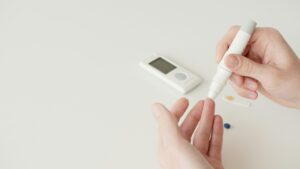
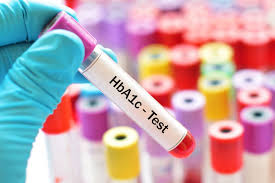 Of course, keep track of your circulating blood levels of glucose and HbA1C, so that you can calibrate your anti-diabetic measures. If it is caught in the process of striking, it will be the triumph of regular tracking. You can stall and, even, reverse it. Reality is: Type II diabetes is the result of insulin resistance of millions of cells in our body, entrenched and irreversible if ignored for long. Like obesity, claims keep coming up of therapies and regimens to cure deep-rooted diabetes. Don’t believe them. Reverse? Yes. Maintain at a reasonable, harmless level? Yes. Cure? No. So,
Of course, keep track of your circulating blood levels of glucose and HbA1C, so that you can calibrate your anti-diabetic measures. If it is caught in the process of striking, it will be the triumph of regular tracking. You can stall and, even, reverse it. Reality is: Type II diabetes is the result of insulin resistance of millions of cells in our body, entrenched and irreversible if ignored for long. Like obesity, claims keep coming up of therapies and regimens to cure deep-rooted diabetes. Don’t believe them. Reverse? Yes. Maintain at a reasonable, harmless level? Yes. Cure? No. So,
- Sustained dietary discipline (not ascetic living), physical exercise, meditation-mediated calmness of mind and gradual reduction in blood glucose levels from persistent compliance may bring fasting and pp glucose levels to pre-diabetic levels from deeply diabetic ones, especially accompanied by medication. But this is not reversal of diabetes; it is merely ‘reduced injections of glucose into blood at a slow rate and sustained burning of it by metabolism’. Sustained for long, it shows results simply by way of large (dx/dt)(∆t) when both the terms are large. It is an unstable state difficult to sustain for long without determination.
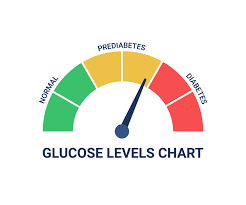 If detected early enough (‘not there 6 months ago but distinctly diabetic today’ or, ideally at pre-diabetic stage) it can be reversed to safe levels but it will still require efforts to keep it in control. We will restrict ourselves strictly to remedies experienced first-hand and observed from close. Given this credibility, it will be extremely useful.
If detected early enough (‘not there 6 months ago but distinctly diabetic today’ or, ideally at pre-diabetic stage) it can be reversed to safe levels but it will still require efforts to keep it in control. We will restrict ourselves strictly to remedies experienced first-hand and observed from close. Given this credibility, it will be extremely useful.- Do consult your physician before adopting any ‘miraculous’ treatment.
Now let’s understand an interesting and important analytical parameter that is a lot more revealing than instantaneous blood glucose levels. It is called HbA1C test.
HbA1C test and its lifestyle importance : We know that haemoglobin is an iron-protein complex in the Red Blood Cells (RBC) in the blood. The oxygen diffusing into the blood in the lungs (ref post 15, Oxygen, food and life: Part I, How oxygen mediates life and food processing) chemically binds with haemoglobin and then disengages that bond and enters the cells to burn glucose to release energy for work and heat. Here, note that glucose enters the cells courtesy the chaperoning by insulin. Note also that oxygen-Hb combination is temperory and designed to break – a kind of courier arrangement or piggy-backing.
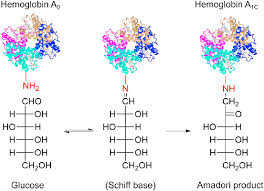 Now, glucose is in the watery part of the blood and haemoglobin, in the RBC but because of natural chemical affinity (un-aided by enzymes) they can chemically team-up. Such chemical combination is called glycation (linking up with a sugar) of haemoglobin and the resulting combination is HbA1C where A1 indicates a type of haemoglobin and it is the most convenient to measure. Note that we are talking about ‘% of red blood cells containing haemoglobin bound to glucose’ when we talk of glycated haemoglobin levels.
Now, glucose is in the watery part of the blood and haemoglobin, in the RBC but because of natural chemical affinity (un-aided by enzymes) they can chemically team-up. Such chemical combination is called glycation (linking up with a sugar) of haemoglobin and the resulting combination is HbA1C where A1 indicates a type of haemoglobin and it is the most convenient to measure. Note that we are talking about ‘% of red blood cells containing haemoglobin bound to glucose’ when we talk of glycated haemoglobin levels.
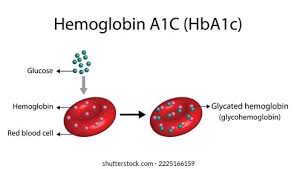 Note: 1. Glucose has the least tendency to bind with Hb among the common food sugars (monosaccharides) viz. glucose, fructose and galactose which is why evolution has given us glucose as the primary energy source. Obviously, glucose bound with Hb is unavailable for energy metabolism.
Note: 1. Glucose has the least tendency to bind with Hb among the common food sugars (monosaccharides) viz. glucose, fructose and galactose which is why evolution has given us glucose as the primary energy source. Obviously, glucose bound with Hb is unavailable for energy metabolism.
- Haemoglobin content of blood is about 14 grams per deciliter (100 ml) but its molecular weight is so large (about 68000 as against glucose’s 180) that it can combine with a very small quantity of glucose.
- The more the blood glucose, the more the Hb-Gl formation in a known pattern. In other words, with the knowledge of HbA1C level at any stage, clinicians can predict what glucose level must have led to that HbA1C level.
- The Hb-Gl combination is irreversible (unlike the Hb-Oxygen one) i.e. if glucose level increases (as in uncontrolled diabetes), a new ‘high’ of Hb-Gl is reached and it persists.
- But there is a complication: the life of an RBC is about 3 months i.e. the RBC’s at the time of measuring HbA1C will have ‘age’ ranging from 1 day to 90 days and millions will have died in the last 3 months – some of them carrying possibly even higher HbA1C levels.
- Clinicians have worked out a way of figuring out how the glycated Hb or HbA1C level must have varied over the last 3 months from today’s reading and hence predict the average HbA1C level over the last 3 months.
So we have two types of diabetes-indicating blood glucose levels:
- Fasting and post-prandial levels expressed as ‘serum or blood glucose, mg per deciliter’. This applies to the ‘time of blood sample drawal’.
- HbA1C level indicating your glucose levels over the last three months (approximately). It is often expressed as % (of RBC with glycated haemoglobin). Try to maintain it at 5 or thereabouts. The lower the better. If you did have a brush with diabetes and are not allowing it to exceed 6, you are doing well but keep it there or lower.
The analytical report will mention your recent blood glucose performance as a % along with the ranges for non-diabetic, pre-diabetic, diabetic and advanced diabetic stages. It is a trend. Modulate daily aerobic activity levels accordingly. Take decisive, structured steps to improve temperament if seriously diabetic; attending self-help groups, seminars, social contacts, avoiding idle over-thinking will help.
Practical food advice for non-diabetics: Diabetes is multi-factorial with hereditary and, to some extent, environmental factors (mainly stress and pollution) which cannot be wished away. In other words, if neither of your parents has diabetes and you live a stress-free, clean life, you can certainly hope for a diabetes-free life.
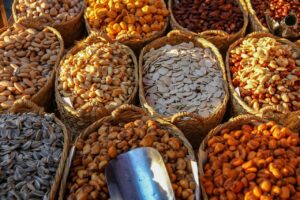 ‘Complex carbohydrates’ is a bit loosely defined term implying ‘mainly starch including resistant starch (ref the previous post) and dietary fiber’ which come from vegetables, fruits (also rich in simple sugars), cereals (wheat, millets, rice, corn), legumes or lentils (daals like arhar or tur, udad, mung), beans (rajma, black-eyed beans or chauli, chhole or bold chickpea). Calibrated against the distribution of your physical activity over the day, prefer them to refined flour (maida), sugar, honey, corn syrup, maple syrup. The diffusion of glucose from complex carbohydrates into the blood will happen after about 2 hours and will be gradual unlike the spike from pure glucose.
‘Complex carbohydrates’ is a bit loosely defined term implying ‘mainly starch including resistant starch (ref the previous post) and dietary fiber’ which come from vegetables, fruits (also rich in simple sugars), cereals (wheat, millets, rice, corn), legumes or lentils (daals like arhar or tur, udad, mung), beans (rajma, black-eyed beans or chauli, chhole or bold chickpea). Calibrated against the distribution of your physical activity over the day, prefer them to refined flour (maida), sugar, honey, corn syrup, maple syrup. The diffusion of glucose from complex carbohydrates into the blood will happen after about 2 hours and will be gradual unlike the spike from pure glucose.

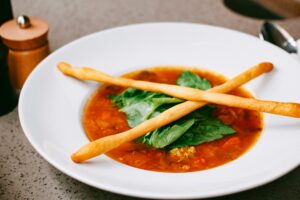 Make dinners light and early. A light walk before hitting the bed is good. Midnight fridge raids are a no-no. Make your lunch the main meal of the day as it gives you ample scope to ‘handle’ its glucose load. Breakfast must take care of a need for glucose after a 12 hour fast but in moderation; use it to also take in protein and fiber.
Make dinners light and early. A light walk before hitting the bed is good. Midnight fridge raids are a no-no. Make your lunch the main meal of the day as it gives you ample scope to ‘handle’ its glucose load. Breakfast must take care of a need for glucose after a 12 hour fast but in moderation; use it to also take in protein and fiber. Ice-cream, chocolate, tea, coffee, aerated beverages, sherbets, milkshakes, sweets, biscuits and cakes, sweetened fruit-juices…..are glucose spikes – hazardous late in the day or when physical activity is not planned. Avoid frequent heavily sugary meals ( a Gujarati style ‘treat’ meal or a marriage reception thali loaded with sweets) late into the night. For the sweet tooth, apart from fresh whole fruit, prefer pulpy fruit juices and low ghee halwas. If frequent, (i) limit quantities, (ii) sometimes sweeten partially with non-calorie sweeteners and (iii) ensure physical activity matching intake.
Ice-cream, chocolate, tea, coffee, aerated beverages, sherbets, milkshakes, sweets, biscuits and cakes, sweetened fruit-juices…..are glucose spikes – hazardous late in the day or when physical activity is not planned. Avoid frequent heavily sugary meals ( a Gujarati style ‘treat’ meal or a marriage reception thali loaded with sweets) late into the night. For the sweet tooth, apart from fresh whole fruit, prefer pulpy fruit juices and low ghee halwas. If frequent, (i) limit quantities, (ii) sometimes sweeten partially with non-calorie sweeteners and (iii) ensure physical activity matching intake.- Understand your calorie requirement and restrict oil/fat-derived calories to less than 30 % of the number. Ensure 20 % of that (or about 5 % of the total) from PUFA oils like soybean, mustard, high-linolenic canola.
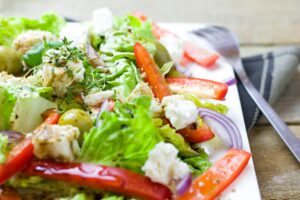
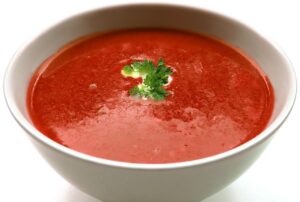
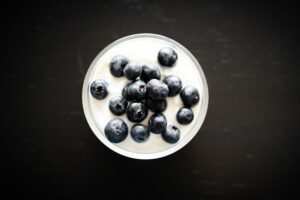
 Generally, prefer salads, soups, low-oil vegetable dishes, pulpy vegetable juices, millets (over rice and wheat), legumes, daals, beans, milk, curd or yoghurts..…Minimize refined flour (maida), sweets, clarified fruit juices, aerated drinks, chocolate, ice-cream, too much tea/coffee……
Generally, prefer salads, soups, low-oil vegetable dishes, pulpy vegetable juices, millets (over rice and wheat), legumes, daals, beans, milk, curd or yoghurts..…Minimize refined flour (maida), sweets, clarified fruit juices, aerated drinks, chocolate, ice-cream, too much tea/coffee……- Depending on age and physician’s advice, time your blood sugar level checks and HbA1C – an illuminating indicator of your recent ‘history’ of glucose levels. After 50, blood glucose (fasting and post-prandial) every 3 months and HbA1C every 6 months is a good idea. More frequently, if results are bothersome and you are tracking them; applies also after 60. Yearly blood lipid profile even with normal blood pressure (refer the posts on CAD). Knowledge is power just as use of food as a tool is.
- Stay physically active and track BMI – ref posts on Obesity. Have hobbies, social life and family bonds.
How to come back from the diabetic brink with food: Your vigilance may be rewarded with the discovery of diabetes trying to sneak into you – the pre-diabetic stage. If you find a blood sugar level reading (fasting and pp) close to pre-diabetic stage, get an HbA1C done and repeat the blood glucose levels after a fortnight. If not sure of interpretation (you shouldn’t be), consult your physician for knowing your status. Good news: most cases, it can be reversed. Religiously follow physician’s advice of follow up tests and have results interpreted. Feel free to ask the physician if you can get away with ‘no medicines’; chances are that you can. I have seen it first hand.


 Advice can be easily derived from the above. Comprehensively, (i) become physically active, (ii) minimize stress and negative emotions, (iii) spread food intake into breakfast, lunch, afternoon snack, dinner; details are available in several previous posts, (iv) avoid refined flour, limit sweets and rice, reduce fat intake, avoid midnight fridge raids, make dinners light and early ideally followed by a walk and (v) monitor blood lipid profile, glucose or sugar and BMI.
Advice can be easily derived from the above. Comprehensively, (i) become physically active, (ii) minimize stress and negative emotions, (iii) spread food intake into breakfast, lunch, afternoon snack, dinner; details are available in several previous posts, (iv) avoid refined flour, limit sweets and rice, reduce fat intake, avoid midnight fridge raids, make dinners light and early ideally followed by a walk and (v) monitor blood lipid profile, glucose or sugar and BMI.
PS: Bitter guard (karela) and Fenugreek seeds and leaves (methi) have been credited with diabetes prevention and management properties. Do visit ‘about us’ to know how we Trivedi’s leverage them. You are advised to adopt them in your own imaginative ways – irrespective of your diabetes status.
Next Post:
Cancer – the scary scourge
If food abuse can cause it, smart food can prevent it
Visit Diclaimer.
2 thoughts on “Dealing with diabetes thru diet – Avoiding, stalling, reversing and living with diabetes using food”
I’d have to examine with you here. Which is not one thing I usually do! I take pleasure in reading a post that may make folks think. Additionally, thanks for permitting me to comment!
Hey! I simply wish to give a huge thumbs up for the good data you will have right here on this post. I shall be coming again to your weblog for more soon.